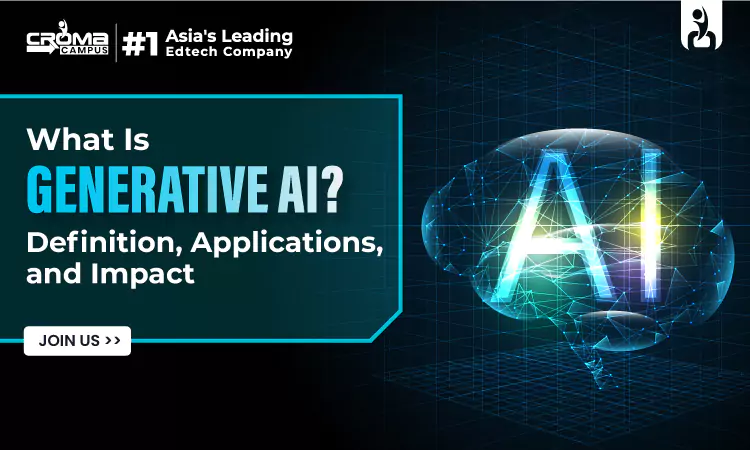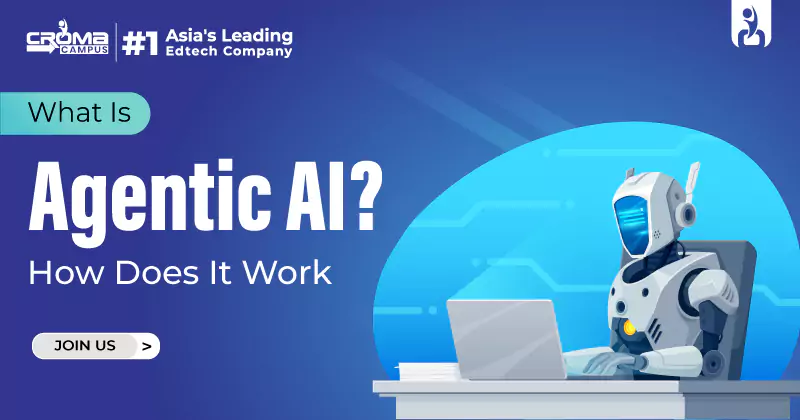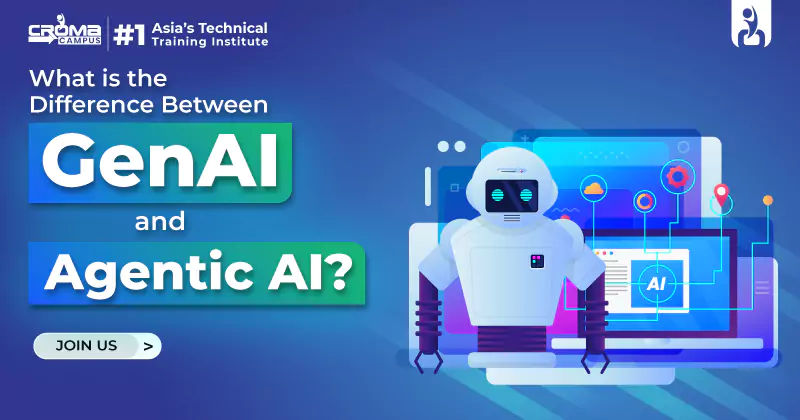What Is Generative AI? Definition, Applications, And Impact
4.8 out of 5 based on 10254 votesLast updated on 31st Jul 2025 16.2K Views
- Bookmark

Generative AI is revolutionizing industries by introducing creativity and making content production easier.

AI (Artificial Intelligence) is simply the process of creating computer programs to be able to do what people with intelligence would normally do, which is to learn, solve problems, make decisions and perceive. AI systems are applications that predict, classify objects, and generate insights using data and algorithms; AI systems allow the creation of a virtual assistant, image recognition, and natural language processing.
What Is Generative AI?
Generative AI: The subset of artificial intelligence that is concerned with creating new content (texts, images, audio, or videos) according to patterns and structures acquired in existing data is known as generative AI. In contrast to older AI models, which study and interpolate information, generative AI models generate novel information that is similar to the entered input information. To further know about it, one can visit the Generative AI Online Course.
Understanding Generative AI
The models of generative AI employ the methods of deep learning, including neural networks, to acquire patterns and relationships between data. Such models can be trained against a large amount of data and, therefore, when fed with a new input, they will be able to produce something of the same style and similar structure to the one they were trained on. Generative AI models have many categories, and they include the following:
- Generative Adversarial Networks (GANs): GANs are one type of neural network in which two networks work together to produce new data. There is a network that creates new data, and there is one that uses the generated data, evaluates it, and can give feedback.
- Variational Autoencoders (VAEs): VAEs are neural networks that learn to compress and reconstruct data. They can also be used to draw samples of new data from the learned distribution.
- Transformer Models: Transformer models represent one of the forms of neural networks specifically suited to the natural language processing task. They can be applied to produce text, translate languages, and so forth.
Applications of Generative AI
Generative AI finds various usages, such as art and design creation and content creation in the forms of text, image, and video. It increases the process of data augmentation for machine learning and drives chatbots to bring human speech-like answers. The applications are marketing-oriented, entertainment-oriented, and education-oriented, among others. It promotes inventiveness and productivity.
- Art and Design: New artworks, designs, and music can be created with Generative AI. The technology has the capability of bringing about a revolution to the creative industries and empowering artists, designers, and musicians to come up with new and innovative content.
- Content Generation: Generative AI can be deployed to create text, images, and video, which can be applied to marketing, entertainment, and learning content. This technology can ease in the automation of the creation of content, which would be more efficient and less costly.
- Data Augmentation: One major role of Generative AI is to generate new data that can enrich the existing dataset and make machine learning models more effective. This technology can transform the machine learning community by making the models capable of learning using vast amounts of data, as well as diverse data.
- Chatbots and Virtual Assistants: Using generative AI, it is possible to create responses that sound like a human being so that the user experience is enhanced. The technology can change the industry of customer service dramatically and allow companies to give their clients more customized and equally beneficial assistance.
Also Read These Blogs:
GenAI Tools Changing Digital Marketing
Techniques Used In Generative AI
Difference Between GenAI And Agentic AI
Career Opportunities in Generative AI
Generative AI is opening up exciting and well-paying career opportunities in today’s tech world. From creating new content to building smart tools, it’s being used in many fields like healthcare, finance, and even entertainment. Some of the top job roles include AI engineer, research scientist, and product manager. But to get into this field, you need strong technical skills and a willingness to keep learning as the technology evolves.
One of the best ways to start your journey is by enrolling in an Agentic AI Course, which helps you understand how generative AI systems think, act, and make decisions. These courses cover both the theory and real-life applications, making you job-ready for roles in companies that are rapidly adopting AI.
- Generative Design Specialist: AI can be used to create and optimize various options of design solutions depending on the target and limitations. Candidate requires possessing good parametric modelling, programming, and design optimisation skills.
- Prompt Engineer AI: Develop prompts that enhance AI responses to maximize efficiency and result in Q and A that is appropriate and true. Writing prompts to use such tools as ChatGPT should be an innovative and knowledgeable process.
- Generative AI Research Scientist: Invent novel generative models and refine existing models to transform AI. This occupation implies the development of benchmark text-to-image tools or the enhancement of large language models.
- AI Product Manager: Drive the product creation of AI-led products and match them with the business and end-user expectations. Control the delivery of AI-driven tools and make sure that products fit the needs of users.
- Synthetic Data Engineer: Develop and control synthetic data to use in training AI models in case the real-world information is unavailable or confidential. This is used to train applications such as AI diagnostic systems in healthcare.
- AI Ethics Specialist: AI systems should be ethical and not break any rules and regulations, but concentrate on being fair, transparent, and accountable. Plug biases into the AI models used in the audit, and make sure that privacy laws are adhered to.
- AI Solutions Architect: Develop and implement AI customised solutions that fit particular business requirements and incorporate generative AI technologies. Develop architecture, choose tool,s and supervise realization.
- Robotics Process Automation Specialist: Remove repetitive tasks done by manual workers through the use of robots powered by AI, which will make the process smooth and efficient.
- AI Content Reviewer/Content Auditor: Check and review AI-generated content, detect possible problems or biases, and give feedback on how to improve it.
- AI Security Specialist: AI security, ensuring after ensuring that the AI systems are safe and strong against possible threats and vulnerabilities.
Impact of Generative AI
Generative AI is revolutionizing industries by introducing creativity and making content production easier. In arts and design, it facilitates the innovation of artistic and design. In the business field, it mechanizes activities, increasing efficiency. There are, however, ethical concerns of bias and transparency.
- Creative Industries: Gen AI could transform the creative industries, allowing artists, designers, and musicians to create new, innovative content. Automation of some tasks can be achieved through this technology, leaving the creatives to accomplish tasks at a higher level.
- Business and Marketing: Generative AI will enable content automation, which increases efficiency and saves costs. This technology can transform the marketing area and allow businesses to produce more personalized and successful content.
- Bias and Ethics: Generative AI also brings to the fore ethical concerns, including the possibility of bias in generated content and its demand for transparency and accountability. These issues will be important in the further evolution of this technology so that in the future, the technology is utilised in a responsible manner
Challenges and Limitations
Examples of drawbacks of generative AI include issues with data quality, as biases within training sets may be imparted in generated data. Measuring the efficiency of models is also complicated, and it demands new measures. Many institutes provide a Python with AI Course, and enrolling in the Python with AI Course can help you start a career in this domain. Also, there are regulatory and ethical issues, the significance of which lies in the transparency and fairness of AI-generated content.
- Data Quality: Generative AI models need quality data on which to learn, and information created by the model can be biased and inaccurate due to the data it was trained on. In that regard, it would be necessary to make sure that training data is diverse, representative, and unbiased.
- Evaluation Metrics: This can be a problematic task to know the quality and effectiveness of generative AI models and may require new measures and techniques of evaluation. With this technology continuing its technological advancement, more advanced evaluation metrics will need to be created that reflect the effectiveness of the generative AI models.
- Regulation and Ethics: Ethics are a major issue in the regulation that generative AI poses, including the required practice of transparency, accountability, and fairness. Regulations will now be critical in developing advanced systems to control generative AI technologically to ensure that the challenges and opportunities in this field are easily dealt with.
Conclusion
Generative AI can change different industries and applications, such as art and design, content production, and data amplification. Nevertheless, it also poses critical issues and constraints, including data quality, evaluation indices, and control and ethics. As generative AI further matures, it will become important to resolve such concerns and see to it that the technology is being developed and applied responsibly. Generative AI could open up novel creativity, fuel innovation, and increase efficiency in an enormous variety of sectors and usages when deployed in the right way.
Subscribe For Free Demo
Free Demo for Corporate & Online Trainings.
















.webp)

.png)















